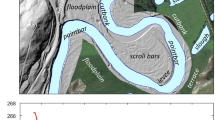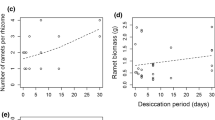Abstract
Spatial patterns of understory plant distribution can reflect availability of suitable abiotic microsites. Hydrastis canadensis is a native, herbaceous perennial whose distribution may be constrained by microsite availability. We planted 5 transects each on south- and north-facing cove hillsides with clonally derived rhizomes of H. canadensis. Transects were spaced 20, 40, 60, 80, and 100 m from a third-order stream. Because the transect 20 m from the stream on the south-facing hillside was adjacent to a natural H. canadensis patch, this transect was postulated to represent suitable habitat. We tested the effects of aspect and distance from stream on phytometer growth measures (survival, leaf area, and both rhizome and leaf area relative growth rates). We also monitored temperature, humidity, and light, then quantified environmental distances for these measures between each transect location and the transect in suitable habitat. Plant growth measures were then regressed on these distances to test hypotheses about factor effects. Neither survival nor relative growth rates depended on aspect or distance from the stream, although leaf area was greater on the north-facing aspect in both years and increased with proximity to the stream in 2003. Rhizome relative growth rate did not depend on any of the environmental distance measures, although leaf area change depended on cumulative light, increasing as the environmental distance from the suitable site increased. The relatively weak association between environmental variation across the forested cove reinforces other studies suggesting that H. canadensis has a relatively broad ecological niche, and its rarity is unlikely due to lack of availability of suitable habitat.
Similar content being viewed by others
References
J. Antonovics R.B. Primack (1982) ArticleTitleExperimental ecological genetics in Plantago: VI. The demography of seedling transplants of P. lanceolata J. Ecol. 70 55–75
S.P. Bratton J.R. Hapeman A.R. Mast (1994) ArticleTitleThe lower Susquehanna River gorge and floodplain (U.S.A.) as a riparian refugium for vernal, forest-floor herbs Conserv. Biol. 8 1069–1077
V.K. Brown A.C. Gange (1989) ArticleTitleRoot herbivory by insects depresses plant species richness Funct. Ecol. 3 667–671
F.S. Chapin SuffixIII A.J. Bloom C.B. Field R.H. Waring (1987) ArticleTitlePlant responses to multiple environmental factors BioScience 37 49–57
Clements, F.E. and Goldsmith, G.W. 1924. The phytometer method in ecology. The plant and community as instruments. Publications of the Carnegie Institution, 356pp.
Clements, F.E., Weaver, J.E. and Hanson, H.C. 1929. Plant competition. An analysis of community functions. Publications of the Carnegie Institution, 398 pp.
J. Davis J.-A. McCoy (2000) Commercial Goldenseal Cultivation North Carolina State University Horticulture Information Leaflet – 131 Raleigh
C.H. Ettema D.A. Wardle (2002) ArticleTitleSpatial soil ecology Trends Ecol. Evol. 17 177–183 Occurrence Handle10.1016/S0169-5347(02)02496-5
D.T.C. Friend (1961) ArticleTitleA simple method of measuring integrated light values in the field Ecology 42 577–580
S.M. Gehlhausen M.W. Schwartz C.K. Augspurger (2000) ArticleTitleVegetation and microclimatic edge effects in two mixed-mesophytic forest fragments Plant Ecol. 147 21–35 Occurrence Handle10.1023/A:1009846507652
H. Lambers F.S. Chapin SuffixIII T.J. Pons (1998) Plant Physiological Ecology Springer-Verlag New York
M.J. Lechowicz G. Bell (1991) ArticleTitleThe ecology and genetics of fitness in forest plants. II. Microspatial heterogeneity of the edaphic environment J. Ecol. 79 687–696
G.R. Matlack (1993) ArticleTitleMicroenvironment variation within and among forest edge sites in the eastern United States Biol. Conserv. 66 185–194 Occurrence Handle10.1016/0006-3207(93)90004-K
B.C. McCarthy R.R. Bailey (1994) ArticleTitleDistribution and abundance of coarse woody debris in a managed forest landscape of the central Appalachians Can. J. Forest Res. 24 1317–1329
J.B. McGraw K. Garbutt (1990) ArticleTitleDemographic growth analysis Ecology 71 1199–2004
J.B. McGraw S.M. Sanders M. der Voort (2003) ArticleTitleDistribution and abundance of Hydrastis canadensis L. (Ranunculaceae) and Panax quinquefolius L. (Araliaceae) in the central Appalachian region J. Torrey Bot. Soc. 130 62–69
J.F. Meekins B.C. McCarthy (2001) ArticleTitleEffect of environmental variation on the invasive success of a nonindigenous forest herb Ecol. Appl. 11 1336–1348
M. Mulligan D.L. Gorchov (2003) Quantifying population loss of goldenseal, Hydrastis canadensis L. in Ohio Savannah Georgia
H. Olff B. Hoorens R.G.M. de Goede W.H. Van der Putten J.M. Gleichman (2000) ArticleTitleSmall scale shifting mosaics of two dominant grassland species: the possible role of soil-borne pathogens Oecologia 125 45–54
A. Packer K. Clay (2000) ArticleTitleSoil pathogens and spatial patterns of seedling mortality in a temperate tree Nature 404 278–281 Occurrence Handle10.1038/35005072 Occurrence Handle10749209 Occurrence Handle1:CAS:528:DC%2BD3cXit1agsb0%3D
A. Pornon N. Escaravage B.I. Till B. Doche (1997) ArticleTitleVariation of reproductive traits in Rhododendron ferrugineum L. (Ericaceae) populations along a successional gradient Plant Ecol. 130 1–11 Occurrence Handle10.1023/A:1009724216796
S. Sanders (2004a) Tests for causes of rarity in goldenseal (Hydrastis canadensis L) West Virginia University Morgantown
S. Sanders (2004b) ArticleTitleDoes breeding system contribute to rarity of goldenseal (Hydrastis canadensis)? Am. Midland Nat. 152 37–42
S. Sanders J.B. McGraw (2002) ArticleTitleDistribution, abundanceand population dynamics of goldenseal (Hydrastis canadensis L.) in an Indiana Nature PreserveUSA Nat. Areas J. 22 129–134
Sanders S. and McGraw J.B. 2005. Harvest recovery of goldenseal Hydrastis canadensis L. Am. Midland Nat. 153: 87–94.
A. Sinclair P.M. Catling (2000a) ArticleTitleStatus of goldenseal, Hydrastis canadensis (Ranunculaceae), in Canada Can. Field-Nat. 114 111–120
A. Sinclair P.M. Catling (2000b) ArticleTitleOntario goldenseal, Hydrastis canadensispopulations in relation to habitat sizepaths, and woodland edges Can. Field-Nat. 114 652–655
M.E. Van der Voort B. Bailey D.E. Samuel J.B. McGraw (2003) ArticleTitleRecovery of populations of goldenseal (Hydrastis canadensis L.) and American ginseng (Panax quinquefolius L.) following harvest Am. Midland Nat. 149 282–292
Wardle, D.A. 2002. Communities and Ecosystems: Linking the Aboveground and Belowground Components. Princeton University Press.
R.H. Whittaker (1975) Communities and Ecosystems Macmillan New York
Author information
Authors and Affiliations
Corresponding author
Rights and permissions
About this article
Cite this article
Sanders, S., McGraw, J. Hydrastis Canadensis L. (Ranunculaceae) Distribution does not Reflect Response to Microclimate Gradients across a Mesophytic Forest Cove. Plant Ecol 181, 279–288 (2005). https://doi.org/10.1007/s11258-005-7222-4
Received:
Accepted:
Issue Date:
DOI: https://doi.org/10.1007/s11258-005-7222-4




